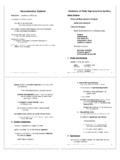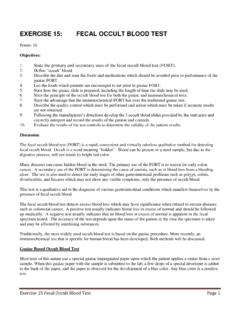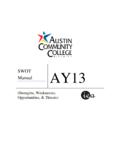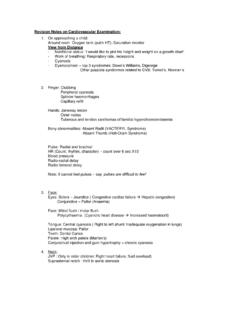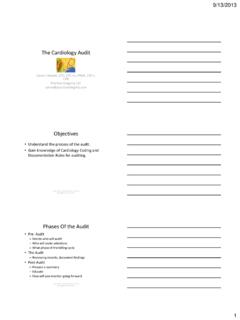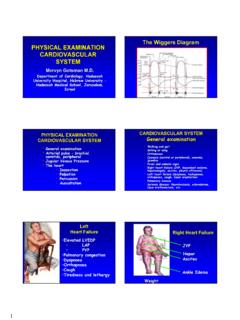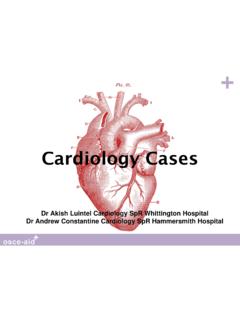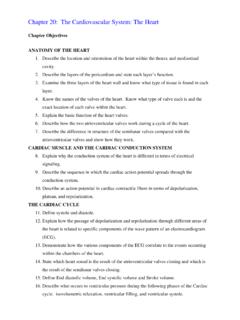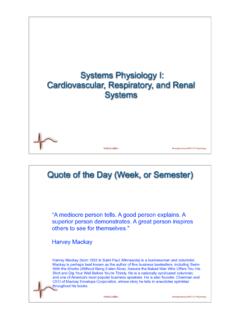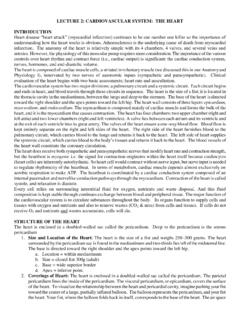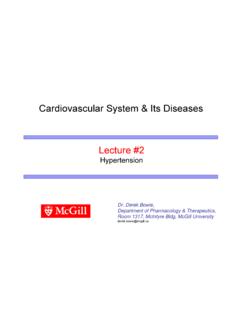Transcription of Cardiovascular Physiology - Austin Community College District
1 Human Anatomy & Physiology : Cardiovascular Physiology Ziser 2404 Lecture notes , 20051 Cardiovascular PhysiologyHeart Physiologyfor the heart to work properly contraction and relaxation of chambers must becoordinatedcardiac muscle tissue differs from smooth and skeletal muscle tissues inseveral ways that suit its function in the heartHistology of Heartcardiac muscle fibers (=cardiocytes)relatively short, thick branched cells, 50-100 m longstriated myofibrils are highly orderedusually 1 nucleus per cellrather than tapering cells are bluntly attached to each other by gap junctions= intercalated discs myocardium behaves as single unitbut atrial muscles separated from ventricular muscles by conductingtissue sheath atria contract separately from ventricles need constant supply of oxygen & nutrients to remain aerobic greater dependence on oxygen than skeletal musclesConducting Systemcardiac muscle cells are not individually innervated as are skeletal muscle cells they are self stimulatingthe rhythmic beating of the heart is coordinated and maintained by the heartconducting systemheart has some specialized fibers that fire impulses to coordinatecontraction of heart
2 Muscleinnervated by autonomic NSHuman Anatomy & Physiology : Cardiovascular Physiology Ziser 2404 Lecture notes , 20052 sympathetic stimulation can raise rate parasympathetic stimulation can lower rateconducting system consists of:SA Nodeintrinsic rhythm70-75 beats/mininitiates stimulus that causes atria to contract(but not ventricles directly due to separation)AV Nodepicks up stimulus from SA NodeAV Bundle (Bundle of His)connected to AV Nodetakes stimulus from AV Node to ventriclesPurkinje Fiberstakes impulse from AV Bundle out to cardiac mucscle fibersof ventricles causing ventricles to contractthe heart conducting system generates a small electrical current that can bepicked up by an electrocardiograph=electrocardiogram (ECG; EKG)ECG is a record of the electrical activity of the conducting system ECG is NOT a record of heart contractionsR P T Q SP wave =passage of current through atria from SA Nodeconduction through atria is very rapidQRS wave=passage of current throughventricles from AV Node AV Bundle PurkinjeFibersimpulse slows as it passes to ventriclesT wave=return to resting conditionsby comparing voltage amplitudes and time intervalsbetween these waves from several leads can getHuman Anatomy & Physiology : Cardiovascular Physiology Ziser 2404 Lecture notes , 20053idea of how rapidly the impulses are being conducted and how the heartis functioningCardiac Cycle1 complete heartbeat (takes ~ seconds)consists of.
3 Systole contraction of each chamberdiastole relaxation of each chambertwo atria contract simultaneouslyas they relax, ventricles contractrelation of ECG to cardiac cyclecontraction and relaxation of ventricles produces characteristic heart sounds:lub-dublub =systolic soundcontraction of ventricles and closing of AV valvesdub =diastolic soundshorter, sharper soundventricles relax and SL valves closeabnormal sounds: murmurs defective valvescongenitalrheumatic (strep antibodies)septal defectsCardiac Output=The amount of blood that the heart pumps/minCO=Heart RateX Stroke volume=75b/m X 70ml/b=5250 ml/min (= l/min)~ normal blood volumeduring strenuous exercise heart may increase output 4 or 5 times thisamountA. Heart Rate:innervated by autonomic branches to SA and AV nodes (antagonisticcontrols)Human Anatomy & Physiology : Cardiovascular Physiology Ziser 2404 Lecture notes , 20054cardiac control center in medulla (cardiac center)receives sensory info from:Baroreceptors (stretch)in aorta and carotid sinusincreased stretch slowerChemoreceptorsmonitor carbon dioxide and pHmore CO2 or lower pH fasterany marked, persistent changes in rate may signal cardiovasculardiseaseB.
4 Stroke Volume:healthy heart pumps ~60% of blood in it normal SV = ~70 mlalso each side of heart must pump exactly the same amount of bloodwith each beat otherwise excess blood would accumulate in lungs or insystemic vesselseg. if Rt heart pumped 1 ml more per beat within 90 minutes the entire blood volumewould accumulate in the lungsStroke Volume is affected mainly by:mean arteriole pressuresystemic blood pressure=back pressurePhysiology of Blood VesselsBlood circulates by going down a pressure gradient to understand circulation we must understand blood pressureBlood Pressure=the driving force of the blood flowing through blood vesselsmeasured as mmHg [ 100 mm Hg = 2 psi, tire ~35psi]changes in pressure are the driving force that moves blood through thecirculatory systemHuman Anatomy & Physiology : Cardiovascular Physiology Ziser 2404 Lecture notes , 20055blood pressure is created by1.
5 The force of the heart beatthe heart maintains a high pressure on the arterial end of thecircuit2. peripheral resistance back pressure, resistance to floweg atherosclerosis inhibits flow raises blood pressureMeasuring Blood Pressureuse sphygmomanometerusually measure pressure in the brachial arteryprocedure:a. increase pressure above systolic to completely cut off blood flow inarteryb. gradually release pressure until 1st spurt (pulse) passes through cuff= systolic pressurec. continue to release until there is no obstruction of flow; soundsdisappear = diastolic pressurenormal BP = 120/80(range: 110-140 / 75-80 [mm Hg])top number = systolic pressureforce of ventricular contractionbottom number = resistance of blood flowmay be more importantindicates strain to which vessels are continuously subjectedalso reflects condition of peripheral vesselsBloodflow in Veinsflow of blood in veins is due to presence of 1 way valves and venous pumps 1 - way valvesprevent backflowmost abundant in veins of limbsquiet standing can cause blood to pool in veins and may causeHuman Anatomy & Physiology : Cardiovascular Physiology Ziser 2404 Lecture notes , 20056faintingvaricose veins: incompetent valves, esp.
6 Superficial veinsmay be due to heredity, prolonged standing, obesitypregnancyhemorrhoids: varicosities of anal veinsdue to excessive pressure from birthing or bowel movementsvenous pumpsmuscular pump (=skeletal muscle pump)during contraction veins running thru muscle are compressedand force blood in one direction (toward heart)respiratory pumpinspiration:creates pressure gradient in Inferior Vena Cavato move blood toward heartexpiration:increasing pressure in chest cavity forces thoracicblood toward heartveins function to collect blood and act as blood reservoirs with large lumens and thin walls they can accommodate relativelylarge volumes of blood 60-70% of all blood is in veins at any timelargest veins = sinuseseg. coronary sinus, dural sinusblood is stored in venous sinusesmost organs are drained by >1 venous brancheven more common than alternate arterial pathways occlusion of veins rarely blocks blood flowremoval of veins during bypass surgery usually not traumaticCapillariesactual site of exchange of materials the rest is pumps and plumbingthin walled - single cell layer thickextremely abundant in almost every tissue of bodyHuman Anatomy & Physiology : Cardiovascular Physiology Ziser 2404 Lecture notes , 20057 most of 62,000 miles of vesselsbut only contains ~5% of blood in bodyeach capillary <1mm longusually no cell >.
7 1 mm away from a capillarytotal surface area of all capillaries in body is estimated at 7000 ft2 spread 250ml (~1 cup) over basketball courtsvariable pressure 35 15 mm Hg; ave=25-12 mmHgCapillary Bedscapillaries ( usually 10 100) are organized into capillary bedsfunctional groupings of capillaries functional units of circulatory systemarterioles and venules are joined directly by metarterioles(become thoroughfare channels after capillaries branch off)capillaries branch from metarterioles1-100/bedcuff of smooth muscle surrounds origin of capillary branches= precapillary sphincteramount of blood entering a bed is regulated by:a. vasomotor nerve fibersb. local chemical conditions
